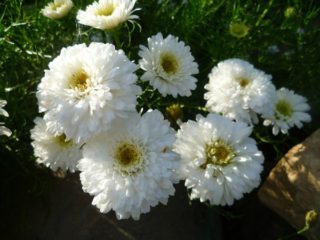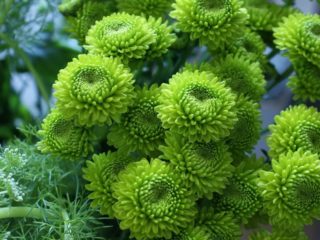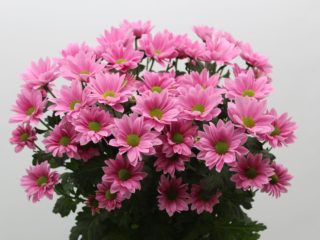Content
- 1 Is it possible to root a chrysanthemum from a bouquet?
- 2 Which chrysanthemums can be propagated by cuttings from a bouquet
- 3 How to prepare cuttings for growing chrysanthemums from a bouquet
- 4 How to grow a chrysanthemum using cuttings from a bouquet
- 5 How to plant a chrysanthemum from a bouquet in open ground
- 6 Useful tips
- 7 Conclusion
Most gardeners strive to root a chrysanthemum from a bouquet. This is not only a creative, but also a profitable process: you can be sure of the color of the buds, there are no costs for purchasing a seedling.
Is it possible to root a chrysanthemum from a bouquet?
There are several ways to propagate a flower. Propagation of chrysanthemums by cuttings is one of the most common methods. To do this, several flowers are selected from the bouquet. The success of the event depends on the correctly selected plant and planting algorithm.

The advantage of rooting is the ability to select a crop with certain varietal characteristics: a clear example allows you to find a specimen that is suitable in color and shape
Which chrysanthemums can be propagated by cuttings from a bouquet
The flower's ability to take root is high, so propagating the plant is easy. But if the specimen for cuttings is chosen poorly, then the chrysanthemum will not take root.
You need to choose the following flower:
- there is no rot on the stems of the crop;
- cuttings are strong, young, green in color and of medium thickness;
- The plant has lateral branches.

It is not recommended to harvest cuttings from non-woody or old shoots of chrysanthemums; the crop will not have enough strength for successful rooting
How to prepare cuttings for growing chrysanthemums from a bouquet
If a chrysanthemum has taken root in a vase, this confirms its viability.

The rooting of the culture should be carried out in compliance with the time frame: the flowers should stand in the bouquet for 1-2 days
Ideally, lateral shoots from the main stem that lack buds should be selected for this purpose. This guarantees successful rooting in a short period of time. If it is impossible to select side branches, cuttings are prepared from shoots of your choice that look strong and healthy.
Features of preparing planting material:
- shorten the selected shoots, leaving 12 cm;
- when cutting the stem, the angle must be maintained so that the uterine stump is partially visible;
- on each chrysanthemum shoot there are 2-3 internodes and more than 2 pairs of leaf blades;
- on selected shoots, pinch the top to make the flower bushier;
- remove buds from shoots;
- Leaves at the bottom of the stem need to be pruned.
In order for cuttings of chrysanthemums from a freshly picked bouquet to be successful, you should provide everything necessary at home: place the selected shoots in a container with purified water. The liquid level in the container should be up to 3 cm.
It is necessary to monitor the freshness of the water in the container: change it no more than once every 2 days.
To speed up the process, you can create a greenhouse effect: wrap a container with water and a plant cutting with a film or cover it with a lid.
Before placing the cutting in a container, it must be treated with the Kornevin stimulator. To do this, place the shoot in the diluted preparation for 2 hours.

Initially, during rooting, callus is formed on the cutting, which contributes to the overgrowth of the cut gradually, from nearby buds on the shoot
The first roots usually form 6-7 days after the shoots are placed in water.
How to grow a chrysanthemum using cuttings from a bouquet
The appearance of roots indicates the viability of the plant. To fully root a chrysanthemum from a given bouquet and then plant it in the fall or spring, you need to move the seedling into the ground.
Preparing the soil and planting container
The optimal time for rooting the selected shoot is January or February. If the bouquet was received in winter, then the entire root system can be formed by spring in order to subsequently transfer the plant to open ground.
If you root a chrysanthemum from a bouquet in March or April, then transplant it to the site in the fall.
When rooting chrysanthemums, it is important to choose the soil: the flower does not like acidic soil. The best option for it is a neutral or slightly acidic substrate. It is recommended to add wood ash to the soil. To increase the fertility of the soil, humus and nitrophoska are mixed with it. Acidity should be determined using indicator strips.

The correct proportions of all substances necessary for a flower are contained in special mixtures that can be found in stores
Often, perlite or hydrogel is preferred for rooting crops. The mixture requires pre-treatment with a manganese solution or calcination.
The flower grows well in loamy and sandy soils, so it is not recommended to neglect drainage: expanded clay or brick chips.
Each chrysanthemum shoot requires its own pot. You can also prepare seedling boxes for the rooting procedure.

All containers must be clean and equipped with ventilation holes
If you subsequently plan to grow the plant in a flowerpot, you should select a container for rooting the chrysanthemum so that its diameter is at least 30 cm. This requirement is based on the characteristics of the root system of the crop: it grows in breadth.
Landing rules
The rooting procedure is simple:
- pour a layer of drainage and soil into the container;
- make a depression in it, place the rooted cutting there;
- water the seedling.
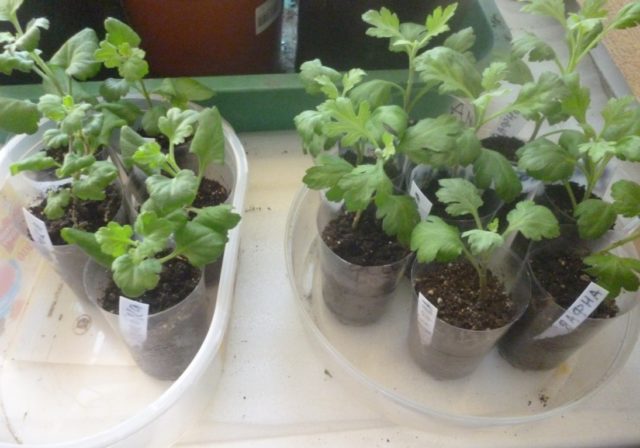
The rooted chrysanthemum must be placed on the windowsill, where the windows face west or east
Caring for chrysanthemum cuttings from a bouquet
After the rooting procedure, the chrysanthemum requires organization of care:
- It is necessary to water it as the soil dries out;
- Regularly moisten the air around the flower using a spray bottle;
- loosen the soil or mulch it with small pebbles or peat.
Fertilizing should not be neglected: it is important to apply fertilizer for the first time 2 weeks after planting in the pot. Universal preparations containing minerals are suitable for this: Kemira, Zdraven. After rooting, chrysanthemums need to be fed twice a month.

Seedlings obtained as a result of rooting chrysanthemums grow very quickly, so they need to be pinched
Removing the growing point forces the shrub to grow into more than one shoot. The procedure should be carried out when the stem increases to 20 cm in length.
How to plant a chrysanthemum from a bouquet in open ground
For Russian cities in the middle zone, the optimal time is the last month of spring or June, for the southern regions it is April and early May.
And although propagation of chrysanthemums by cuttings obtained from a donated bouquet is possible in the fall, gardeners prefer spring. It will be easier for the seedling to take root over the summer and settle down before frost sets in.
Landing algorithm:
- prepare holes, retreating from each hole 40 cm in length and 40 cm in width;
- Place stones at the bottom of the holes for drainage;
- remove the seedlings with a clod of earth, place them in a hole, deepen them and cover them;
- Water the chrysanthemums generously.
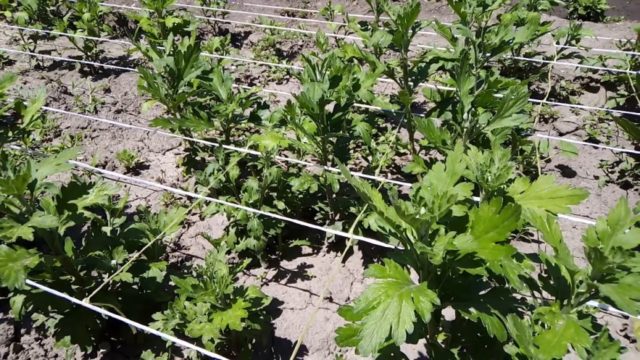
It is recommended to tie the flower or organize a support for it
For several days after planting, the rooted chrysanthemum should be covered with film so that the plant takes root faster
Useful tips
Chrysanthemum is a beautiful but capricious flower. When growing it on a site, it is necessary to allocate a special place; there should be no drafts, dense shade, or moisture. Wetland gardens located in lowlands or often flooded in the spring are also not suitable for cultivating chrysanthemums.
The flower will bloom profusely and for a long time if it grows on fertile soil, the pH should be from 5.5 to 7.0.
A common pest that destroys chrysanthemum leaves is aphids. It quickly spreads throughout the plant and spreads to nearby crops.

A safe method of killing aphids is a soap solution, which is used to periodically treat the bush until the pest completely disappears.
Other tips for taking chrysanthemum cuttings:
- if the flower has taken root on its own while in the vase, then it can be transferred entirely to open ground;
- when transplanting an adult bush into the garden, you should trim the main stem, retaining only 4-5 leaf blades (this procedure will stimulate root formation);
- if buds have formed on a rooted cutting, then they need to be completely removed (the plant does not have enough reserves to form a full-fledged root system);
- For young flowers, low temperatures are destructive, so it is recommended to cover them, or remove them along with the soil and move them indoors (to the balcony or basement), where they will safely overwinter.
Some gardeners prefer to plant crops on site directly in plastic containers so that they can dig up shrubs in the fall without damaging the roots.
Conclusion
Any motivated gardener can root a chrysanthemum from a bouquet: patience and competent care will ensure the success of the event.Depending on the varietal characteristics, buds usually form from late August to November, unless there are severe frosts. The plant can be safely propagated on its own and replanted if necessary.



